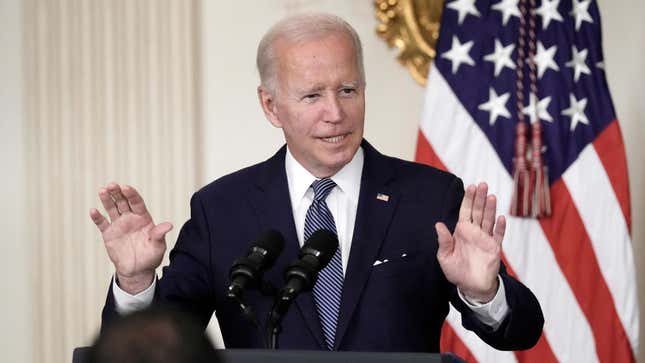A ‘Drop in the Bucket’ for Many: Let’s Put Biden’s Student Loan Relief in Perspective
For those with large debt burdens, forgiving $10,000 isn't very much. And it only applies to those making less than $125,000 per year.
Politics

President Joe Biden on Wednesday announced that his administration will forgive $10,000 of federal student debt for borrowers who make less than $125,000 per year (and $20,000 for those who received Pell Grants), sort of fulfilling a key promise the president made on the 2020 campaign trail. He also announced an extension to the freeze on federal student loan payments.
The news was expected, and the lead-up to it came with mixed reactions. There are the usual critics—often right-wingers or people who attended college when it cost “$10 and a handy”—who say student debt cancellation is unfair to those who’ve already paid off their loans. Others are borrowers who say the move may be a step forward but isn’t enough, even for individuals who make what’s considered “good” money, perhaps around or above the $125,000 cap. That runs counter to the popular narrative that most professionals—particularly those with law or medical degrees—who graduated with student debt don’t need forgiveness, because they supposedly make more than enough to pay off their loans.
Currently, about 45 million people in the U.S. owe a combined $1.7 trillion in student loans, and research has shown Black women in particular are the most impacted by student debt. People who took out money to pay for college and graduate school work in varied fields with varied incomes, but even those who are able to live relatively comfortably say their debt continues to shape nearly every aspect of their lives. Some, like William Mees, weren’t even able to complete advanced degrees for which they accumulated significant debt: Mees told Jezebel he dropped out of pharmacy school after 1.5 years but over the course of that period took out “more than $100,000 in student debt.” He’s not alone: Between 2011 and 2017, 38.6 percent of people who took out student loans didn’t complete their education in that time period.
Meanwhile, the economy isn’t doing great. The U.S. inflation rate reached a 40-year peak back in June at 9.1%. Rent is spiking in cities across the country; a recent study found raising one (1) single child costs upwards of $300,000; and the federal minimum wage has stood at $7.25 since 2009. Even for those with considerably more economic privilege than others, student debt is a drain on resources at an increasingly difficult time, and wiping away just $10,000 may not offer much in the way of relief for many people.
-

-

-

-

-

-

-

-

-

-

-

-

-

-

-

-

-

-

-

-

-

-

-

-

-

-

-

-

-

-

-

-

-

-

-

-

-

-

-

-








































